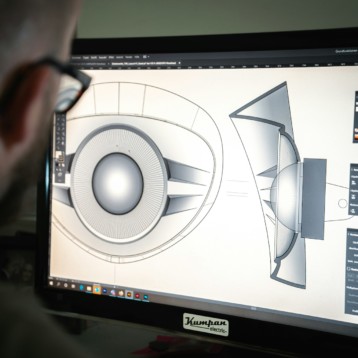Following the introduction of the memristor in May 2008, HP engineers have recently unveiled the first functioning memristor circuit at the inaugural Memristor and Memristor Systems Symposium. By substituting some transistors with memristors, the team has created more physical space for more components to be added, increasing the computing power in the process (and possibly reducing energy consumption).
 |
The memristor team: (from left) Dmitri Strukov,
Stan Willams, Duncan Stewart, Greg Snider
(Credit: Brett Bausk, HP) |
|
The history of memristors dates back to 1971, when Professor Leon Chua published a controversial paper stating that a component named ‘memristor’ should be included as the fourth fundamental circuit element together with the resistor, capacitor and inductor. Chua claimed that memristors had properties that could not be reproduced by any combination of the other three elements.
The characteristic element of a memristor is that when an AC voltage is applied to the device, the current-voltage (I-V) plot is a
Lissajous figure (the curve formed by combining two oscillations that are perpendicular to each other). In other words, the current versus voltage plot shows a pinched loop where current and voltage are zero at the same point or easily represented by the ‘figure 8’. In practical terms, the memristor performs similarly to a resistor, but it is able to alter its resistance to the amount and direction of the voltage applied. Furthermore, even when there is no power supplied to the memristor, it can still ‘remember’ its resistance.
Fast-forwarding to 2007, the HP team was the first to realise that the
hysteresis that was detected in the I-V curves of an extensive range of materials and structures, was in fact the outcome of
memristance.They pursued this discovery to develop an elementary circuit model that was based on the exact mathematical equations as those calculated by Chua for the memristor.
 |
Researchers removed transistors
from the bottom layer of this
silicon-based chip (shown in yellow
and blue) and replaced them with
fewer memristors in the
top layer (shown in red).
Memristors can do the work of
transistors but require less
power and space.
(Credit: Qiangfei Xia, HP) |
|
The HP team was able to create the first hybrid memristor-transistor chip, which could potentially be cheaper and more energy efficient than existing chips. Lead researcher Stan Williams, a senior research fellow at HP said that so far increasing performance has usually meant shrinking components so that more can be packed onto a circuit. But in this case, Williams’s team removed some transistors and replaced them with a smaller number of memristors. “We’re not trying to crowd more transistors onto a chip or into a particular circuit,” Williams says. ”Hybrid memristor-transistor chips really have the promise for delivering a lot more performance.”
Williams also states that manufacturing and integration of memristors would be efficient, as the chips and memristors are made out of the same material as normal integrated circuits. The team also developed a
field-programmable gate array (FPGA) using memristors and transistors, where the memristors were made from the
semiconductor titanium dioxide.
The function of FGPAs is mainly in chip prototype testing. It is a favourite among engineers because the board can be designed and reprogrammed according to the specifications of engineer. The only downside of FPGAs is the high price and large, bulky board. If the application of the memristors into FPGAs is successful, it would lower the costs notably and help the introduction of memristors into the market.
The memristor could also be applied to existing
flash storage or
dynamic random access memory (DRAM). A memristive device can function in both digital and analog forms, both having very diverse applications. In digital mode, it could substitute conventional solid-state memories (Flash) with high-speed and less steeply priced
nonvolatile random access memory (NVRAM). Eventually, it would create digital cameras with no delay between photos or computers that save power by turning off when not needed and then turning back on instantly when needed.
With so few institutions able to manufacture, let alone design memristors, Williams feels that it would take at least three more years for the memristor circuit to be applied in commercial circuits. The team at HP Labs hope that future memristors will be faster, smaller and more energy-efficient.
TFOT has previously covered the
New Speed Record for Magnetic Memories about a spin-torque switching called ballistic switching, which could allow for increased speeds in future non-volatile magnetic memories. TFOT also covered the
World’s Tiniest Nanophotonic Switch capable of sending information inside a computer chip by using light pulses. You can also check out our article about
Graphene Semiconductors which could replace conventional semiconductor materials such as silicon in applications ranging from high-speed computer chips to biochemical sensors.
Additional information on the memristor can be obtained at
HP’s website.












